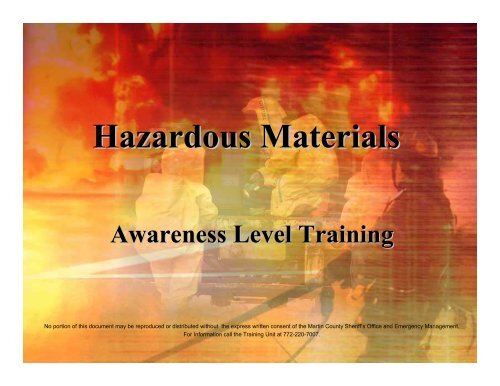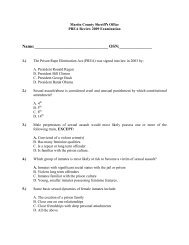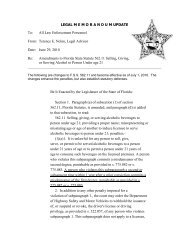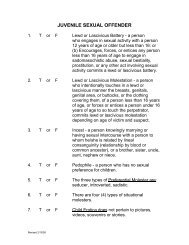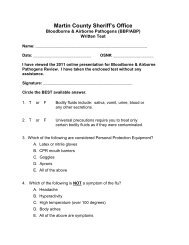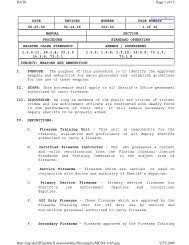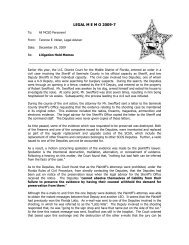HazMat Presentation - Martin County, Florida
HazMat Presentation - Martin County, Florida
HazMat Presentation - Martin County, Florida
Create successful ePaper yourself
Turn your PDF publications into a flip-book with our unique Google optimized e-Paper software.
Hazardous Materials<br />
Awareness Level Training<br />
No portion of this document may be reproduced or distributed without the express written consent of the <strong>Martin</strong> <strong>County</strong> Sheriff’s Office and Emergency Management.<br />
For Information call the Training Unit at 772-220-7007.
Hazardous Materials<br />
Awareness Level Training<br />
UNIT 1 - “Preparation for Response”
Unit 1 Objectives<br />
• Identify OSHA and EPA training<br />
requirements<br />
• Identify the role of the Awareness Level First<br />
Responder<br />
• Identify the roles of the Local Emergency<br />
Planning Committee (LEPC) and the State<br />
Emergency Response Commission (SERC)<br />
2008 Haz-Mat Review<br />
3
Hazardous Materials<br />
• Defined in numerous ways<br />
– U.S. Department of Transportation (DOT)<br />
– U.S. Environmental Protection Agency (EPA)<br />
– U.S. Occupational Safety and Health<br />
Administration (OSHA)<br />
• Simplified Definition<br />
• Extremely Hazardous Substances<br />
2008 Haz-Mat Review<br />
4
Simplified Definition<br />
Any substance or material (solid, liquid or gas) that<br />
when released into the environment is capable of<br />
causing damage, injury, illness or death.<br />
2008 Haz-Mat Review<br />
5
Extremely Hazardous Substance (EHS)<br />
• EPA defines an EHS as a hazardous material<br />
which would present a significant risk to the<br />
surrounding community and/or environment<br />
should it be released.<br />
• These materials have the potential to migrate<br />
offsite of the release and move throughout the<br />
environment, presenting an immediate health<br />
and safety hazard.<br />
2008 Haz-Mat Review<br />
6
Hazardous Materials Incidents<br />
These incidents are unique because they require<br />
specialized protective measures not normally<br />
available to first responders AND they demand<br />
a different operational approach!<br />
2008 Haz-Mat Review<br />
7
Mechanisms of Harm<br />
Thermal<br />
Etiological<br />
Asphyxiation<br />
Mechanical<br />
Chemical<br />
Psychological<br />
Radiological<br />
T.E.A.M. C.P.R.<br />
2008 Haz-Mat Review<br />
8
Public Safety “Duty to Act”<br />
• Public safety responders have a “Duty to Act”.<br />
• Your level of involvement is defined by your<br />
employer’s Emergency Response Plan (ERP).<br />
• The actions you are expected to take should be in<br />
Standard Operating Guidelines format.<br />
• NEVER exceed your level of training and protection!<br />
2008 Haz-Mat Review<br />
9
Response Goals<br />
Recognition<br />
Isolation<br />
Protection<br />
Notification<br />
Time and Distance<br />
2008 Haz-Mat Review<br />
10
Emergency Response Guidebook<br />
• The ERG is a responder’s tool for success.<br />
• Every emergency vehicle should have an ERG.<br />
• Purpose:<br />
– An aid for identification of the material<br />
involved.<br />
– Outlines basic initial actions.<br />
– Recommends protective action areas.<br />
– Serves as an initial incident safety plan.<br />
– National and international emergency<br />
contact phone numbers.
Federal and State Regulations<br />
• Congress passed the Emergency Planning and<br />
Community Right-To-Know Act (EPCRA) in 1986<br />
• <strong>Florida</strong> Legislature passed the <strong>Florida</strong> Hazardous<br />
Materials Emergency Response and Community<br />
Right-to-Know Act in 1988<br />
• EPCRA, Section 126 mandated that OSHA develop<br />
safety regulations for first responders.<br />
• EPCRA requires local communities and facilities to<br />
plan and prepare for hazardous materials<br />
emergencies.<br />
2008 Haz-Mat Review<br />
12
Development of LEPC<br />
• What is LEPC – Local Emergency Planning Committee<br />
• Background - The District X LEPC is one of eleven district<br />
committees in <strong>Florida</strong>. District X comprises the following counties:<br />
Palm Beach, <strong>Martin</strong>, St. Lucie, and Indian River<br />
• The LEPC includes members from the following: law enforcement,<br />
emergency management, fire fighting, first aid, health,<br />
environmental interests, hospitals, elected state officials,<br />
transportation personnel, water management districts, media,<br />
owners and operators of facilities subject to the requirements of<br />
Emergency Planning & Community Right-To-Know Act (EPCRA),<br />
interested citizens, and non-elected and elected local officials.
Identify facilities<br />
and transportation<br />
routes<br />
Develop SOP’s for<br />
facility and emergency<br />
personnel<br />
Designate<br />
community and<br />
facility coordinators<br />
Develop timely<br />
detection and<br />
notification<br />
procedures<br />
LEPC<br />
Maintain regional<br />
emergency response<br />
equipment and<br />
facilities lists<br />
Maintain<br />
evacuation plans<br />
Test and exercise<br />
hazmat plans<br />
Provide training<br />
2008 Haz-Mat Review<br />
14
Hazardous Waste Operations and<br />
Emergency Response (HAZWOPER)<br />
• OSHA and EPA’s safety standard which was<br />
developed in accordance with the mandate of<br />
EPCRA, Section 126.<br />
• Codified as OSHA 29 CFR 1910.120 and EPA 40<br />
CFR 311.<br />
• Enforced by OSHA.<br />
2008 Haz-Mat Review<br />
15
Five Levels of Training<br />
• First Responder Awareness Level<br />
• First Responder Operational Level<br />
• Hazardous Materials Technician<br />
• Hazardous Materials Specialist<br />
• Hazardous Materials Incident Commander<br />
2008 Haz-Mat Review<br />
16
Operational Modes<br />
• Awareness and Operational level responders<br />
take DEFENSIVE actions.<br />
• Technicians and Specialists take OFFENSIVE<br />
actions.<br />
• The Incident Commander coordinates the<br />
response and is ultimately responsible for<br />
safety.<br />
2008 Haz-Mat Review<br />
17
Unit 1 Summary<br />
• Definition of hazardous materials and how<br />
they differ from other emergencies<br />
• T.E.A.M.C.P.R.<br />
• Duty to Act and Standard of Care<br />
• Roles for awareness responders - R.I.P.NOT!<br />
• EPCRA and the Employer’s Emergency<br />
Response Plan<br />
• Five levels of training<br />
• Two operational modes<br />
2008 Haz-Mat Review<br />
18
First Responder<br />
Awareness Level Training<br />
UNIT 2 - “Hazard Identification”<br />
2008 Haz-Mat Review<br />
19
Unit 2 Objectives<br />
• Identify the six clues to the presence of<br />
hazardous materials.<br />
• Identify the various hazard classes of<br />
hazardous materials.<br />
• Describe ways in which you can determine the<br />
specific identity of a hazardous material.
Response Goals<br />
Recognition<br />
Isolation<br />
Protection<br />
Notification<br />
Time and Distance<br />
2008 Haz-Mat Review<br />
21
Six Basic Clues to Recognition<br />
1 - Occupancy and location<br />
2 - Container shape and size<br />
3 - Placards and labels<br />
4 - Shipping papers/facility<br />
documents<br />
5 - Markings and colors<br />
6 - Human senses<br />
2008 Haz-Mat Review<br />
22
Clue #1 - Occupancy and Location<br />
• Specific occupancy or general<br />
area<br />
• Fixed facilities<br />
• Five modes of hazardous<br />
materials transportation<br />
– Rail, air, marine, highway and<br />
pipeline<br />
• Drug lab considerations<br />
2008 Haz-Mat Review<br />
23
Clue #1 – Illegal Operations<br />
Illegal Operations (Drug Labs)<br />
• Chemical hazards vary<br />
• Booby traps<br />
• Labs can be found anywhere<br />
Some clues to the presence of a drug lab:<br />
• Unusual traffic<br />
• Chemical odors<br />
• Fortified<br />
• Occupants smoke outside<br />
2008 Haz-Mat Review<br />
24
Clue #2 - Container Shape and Size<br />
• Classifications<br />
– Portable, fixed or transportation<br />
– Refer to the Rail and Road Identification Chart in the ERG<br />
• Pressure<br />
– Non-pressurized, low or high pressure<br />
• Vapor Pressure and Storage<br />
– The higher the pressure, the greater the potential for catastrophic<br />
failure<br />
– BLEVE<br />
2008 Haz-Mat Review<br />
25
Clue #3 - Placards and Labels<br />
• Placards and their limitations<br />
– Not always required<br />
– 1000 pound rule<br />
• Placards and labels used for transport<br />
are based upon DOT Hazard Class<br />
– Refer to the ERG Table of Placards<br />
• Nine Hazard Classes<br />
– Subdivided into divisions<br />
– Refer to the ERG Hazard<br />
Classification System<br />
2008 Haz-Mat Review<br />
26
Hazard Class 1 - Explosives<br />
Six Subdivisions<br />
1.1 - Mass explosion hazard<br />
1.2 - Projectile hazard<br />
1.3 - Fire, minor blast or projectile<br />
1.4 - Minor explosion<br />
1.5 - Very insensitive explosives<br />
1.6 - Extremely insensitive<br />
2008 Haz-Mat Review<br />
27
Hazard Class 2 - Gases<br />
• Pressurized or liquefied<br />
• Product and container present<br />
hazards<br />
• Three Subdivisions<br />
2.1 - Flammable gases<br />
2.2 - Non-Flammable, Non-Poisonous<br />
2.3 - Poisonous Gases<br />
2008 Haz-Mat Review<br />
28
Hazard Class 3 -<br />
Flammable/Combustible Liquids<br />
• Flammable Liquids can be ignited at<br />
room temperature<br />
• Combustible Liquids require some<br />
degree of pre-heating to ignite<br />
• Number 1 rule - eliminate ignition<br />
sources<br />
2008 Haz-Mat Review<br />
29
Hazard Class 4 - Flammable Solids<br />
Three Subdivisions<br />
4.1 - Flammable Solids<br />
4.2 - Spontaneously Combustible<br />
4.3 - Dangerous When Wet<br />
2008 Haz-Mat Review<br />
30
Hazard Class 5 – Oxidizing Substances<br />
and Organic Peroxides<br />
• Oxidizers release oxygen to enhance<br />
or intensify the burn<br />
• With strong fuels, oxidizers can<br />
create conditions which can lead to<br />
violent combustion<br />
• Many Organic Peroxides are very<br />
unstable<br />
2008 Haz-Mat Review<br />
31
Hazard Class 6 - Toxic and<br />
Infectious Substances<br />
• Poisonous to human<br />
– Can include severely irritating<br />
substances<br />
– “Tear Gas”, Hydrocyanic acid,<br />
Carbon Tetrachloride<br />
• Infectious Substances<br />
– Potential to cause diseases in humans<br />
– Anthrax, human blood and many<br />
body fluids<br />
2008 Haz-Mat Review<br />
32
Hazard Class 7 - Radioactive Materials<br />
• Ionizing radiation hazard<br />
• Exposure does not always<br />
result in contamination<br />
• Safety Rules:<br />
Time, Distance and Shielding<br />
• Shipped in specialized<br />
containers<br />
2008 Haz-Mat Review<br />
33
Hazard Class 8 - Corrosives<br />
Materials which cause destruction to human<br />
skin tissue or a liquid that has a severe<br />
corrosion rate on steel.<br />
2008 Haz-Mat Review<br />
34
Hazard Class 9 - Miscellaneous<br />
Hazardous Materials<br />
• ORM A - Dry Ice<br />
• ORM B - Quick Lime, Metallic<br />
Mercury<br />
• ORM C - Asphalt, Battery parts<br />
• ORM D - Consumer commodities<br />
• ORM E - Hazardous substances<br />
and hazardous wastes<br />
2008 Haz-Mat Review<br />
35
Pesticide Labels<br />
• Product name<br />
• Active ingredients<br />
• Signal word<br />
– Caution<br />
– Warning<br />
– Danger (Poison)<br />
• Precautionary statements<br />
2008 Haz-Mat Review<br />
36
Slide Activity<br />
Have the students turn to the pages of the ERG which shows<br />
the pictographs of all the placards and labels which we have<br />
discussed. Ask the students to select a label which would best<br />
identify the following materials:<br />
Liquid pesticide<br />
Gasoline<br />
An acid<br />
A gas used for killing insects<br />
An explosive<br />
Answer - Poison<br />
Answer - Flammable Liquid<br />
Answer - Corrosive<br />
Answer - Poison Gas<br />
Answer – Explosives<br />
Discuss the selection with the students. Reinforce that the<br />
material need not be absolutely identified in order to make a<br />
decision with regard to safety.<br />
2008 Haz-Mat Review<br />
37
Clue #4 - Shipping Papers and<br />
Facility Documents<br />
MODE NAME LOCATION NOTES<br />
Highway<br />
Rail<br />
Water<br />
Bill of Lading<br />
or Freight Bill<br />
Consist List or<br />
Waybill<br />
Dangerous<br />
Cargo<br />
Manifest<br />
Cab of vehicle<br />
With conductor or<br />
engineer<br />
Wheelhouse or vessel<br />
or document tube or<br />
box on barge<br />
Air Airbill Cockpit and outside of<br />
packages<br />
Pipeline<br />
Pipeline<br />
Markers<br />
Where pipeline crosses<br />
another mode of<br />
transportation<br />
2008 Haz-Mat Review<br />
In arms reach of<br />
driver<br />
Itemized listing of<br />
each car in train<br />
In possession of the<br />
pilot<br />
Indicates owners<br />
name and 24 hour<br />
contact information<br />
38
Facility Documents<br />
• Material Safety Data Sheet (MSDS)<br />
– Required for hazardous substances which are<br />
stored, manufactured, or used in the work place<br />
– Provides a variety of information such as product<br />
identification, physical/chemical properties, fire<br />
data, health data, reactivity data, etc.<br />
• Other facility documents<br />
– Emergency Response Plans (ERP)<br />
– Emergency Action Plans (EAP)<br />
2008 Haz-Mat Review<br />
39
Clue #5 - Markings and Colors<br />
• Container colors are not always standardized<br />
• DOT identification numbers<br />
2008 Haz-Mat Review<br />
40
Clue #5 - NFPA 704 Diamond<br />
2008 Haz-Mat Review<br />
41
Clue #6 - Human Senses<br />
High<br />
TASTE<br />
TOUCH<br />
RISK<br />
LEVEL<br />
SMELL<br />
SIGHT<br />
Low<br />
SOUND<br />
2008 Haz-Mat Review<br />
42
Methods of Identification<br />
• Once you recognize, try to identify<br />
• Location of material name<br />
– Shipping papers<br />
– Identification Numbers<br />
– MSDSs (fixed facilities)<br />
– Facility Pre-Plans<br />
– Employees and bystanders<br />
• If you cannot safely identify, try to classify the<br />
material into a hazard class<br />
2008 Haz-Mat Review<br />
43
Weapons of Mass Destruction (WMD)<br />
C - Chemical<br />
B - Biological<br />
R - Radiological<br />
N - Nuclear<br />
E – Energetic<br />
(Explosives and<br />
Incendiary)<br />
2008 Haz-Mat Review<br />
44
Terrorist Activity – Target Locations<br />
• Public assembly areas and mass transit systems, i.e. subways,<br />
buses<br />
• Government buildings and historic or symbolic sites<br />
• Areas of significant economic impact, i.e. regional shopping<br />
centers<br />
• Religious or controversial organizations<br />
• Industrial and military facilities<br />
• First Responders may intentionally be targeted to increase<br />
the impact of the attack.<br />
2008 Haz-Mat Review<br />
45
What Is Terrorism?<br />
The unlawful use of force or violence<br />
committed by a group or individual against<br />
persons or property to intimidate or coerce<br />
a government, the civilian population, or<br />
any segment thereof, in furtherance of<br />
political or social objectives.<br />
--U.S. Department of Justice<br />
2008 Haz-Mat Review<br />
46
Targets in OUR Area?<br />
• Schools<br />
Theme Parks<br />
• Water Treatment<br />
Plant<br />
• Herbert Hoover<br />
Dike<br />
Nuclear Power Plants<br />
2008 Haz-Mat Review<br />
NASA<br />
Government Officials<br />
47
Chemical versus Biological Incident<br />
Chemical incidents can be identified by the following:<br />
• Rapid onset of medical symptoms characteristic of chemical<br />
exposure<br />
• Natural indicators<br />
• Chemical residue and odors<br />
• Indications of a hazardous materials release, i.e. plume or<br />
cloud<br />
Biological incidents can be identified by the following:<br />
• Gradual onset of medical symptoms without obvious odors<br />
or colors<br />
• Wide spread migration of the illness<br />
• Infectious individuals transmitting to others<br />
2008 Haz-Mat Review<br />
48
Unit 2 Summary<br />
• Goals of recognition and identification<br />
– Recognize, Classify, Identify<br />
• Six clues to the presence of hazardous<br />
materials<br />
– Occupancy and location, container shape and size,<br />
placards and labels, shipping papers and facility<br />
documents, markings and colors, the human senses<br />
• There are nine general classes of hazardous<br />
materials<br />
2008 Haz-Mat Review<br />
49
First Responder<br />
Awareness Level Training<br />
UNIT 3 - “Taking Control”<br />
2008 Haz-Mat Review<br />
50
Unit 3 Objectives<br />
• The necessary actions to be taken to isolate<br />
the incident.<br />
• Identify the procedures for initiating the ERP.<br />
• Identify the procedures for implementing<br />
protective action distances.
Emergency Response Guidebook<br />
• Origin<br />
• Goal<br />
• Purpose & Limitations<br />
2008 Haz-Mat Review<br />
52
Steps for Proper Use of the ERG<br />
• Recognize & Identify Hazardous Materials<br />
– Name<br />
– Four digit ID number<br />
– Placard description<br />
• Look up the guide page number<br />
• Take basic protective actions according to the<br />
guide page<br />
• Initiate isolation and evacuation according to<br />
protective action distances<br />
2008 Haz-Mat Review<br />
53
ERG Yellow Pages<br />
Lists chemicals by the four digit ID number<br />
The number is found on shipping papers,<br />
on the face of the placard, or in a box<br />
adjacent to a placard on a vehicle<br />
Armed with the ID number, you will learn<br />
the name(s), and the Guide number to be<br />
referred to in the ERG for basic guidance<br />
2008 Haz-Mat Review<br />
54
2008 Haz-Mat Review<br />
55
ERG Blue Pages<br />
Lists chemicals alphabetically<br />
The name may be found on shipping<br />
papers, informative labels, on the vessel,<br />
etc.<br />
From this listing you can learn the ID<br />
number and Guide number<br />
2008 Haz-Mat Review<br />
56
2008 Haz-Mat Review<br />
57
The Green Pages<br />
The green section is the Table of Initial Isolation<br />
and Protective Action Distances<br />
It is listed by the ID number<br />
Chemicals in the yellow and blue sections which<br />
are color highlighted should be further<br />
researched in the green section<br />
The table lists isolation distances (total<br />
evacuation of uncontaminated personnel) and<br />
distances for downwind protection<br />
2008 Haz-Mat Review<br />
58
Green Pages - continued<br />
It shows small spills, defined as a small<br />
package (roughly less than a drum or a<br />
small leak from a large container), and<br />
large spills.<br />
For rank and file, it shows you where you<br />
can be located<br />
For supervisory and command personnel,<br />
it outlines the size of an incident, and<br />
gives them guidance as to manpower<br />
resources needed to safely maintain the<br />
situation<br />
2008 Haz-Mat Review<br />
59
2008 Haz-Mat Review<br />
60
Basic Protective Actions<br />
Precautions to protect yourself and others in a<br />
hazardous materials incident:<br />
– Approach an incident from upwind and uphill<br />
– Upwind always takes priority<br />
– If you cannot approach from upwind stay<br />
further away<br />
– Use binoculars to identify labeling<br />
– Look for all hazards<br />
– Relay hazards and safety information to others<br />
2008 Haz-Mat Review<br />
61
Control Zones<br />
WIND<br />
Incident<br />
Entry Corridor<br />
Command area,<br />
Support<br />
functions<br />
Safe<br />
Refuge<br />
Decontamination<br />
HOT WARM COLD<br />
2008 Haz-Mat Review<br />
62
Protective Action Options<br />
• Shelter in-place<br />
– Short duration incidents<br />
– Greater hazard to attempt<br />
to move<br />
– Impractical to evacuate<br />
• Evacuation<br />
– Potential for massive fire or<br />
explosion<br />
– Long duration incidents<br />
2008 Haz-Mat Review<br />
63
Incident Command System (ICS)<br />
• Initiate ICS, it assists to identify those authorized to<br />
enter the scene<br />
• The first responder implements ICS<br />
• Review the ICS specified in the ERP and SOGs<br />
• Requires appointment of a safety officer<br />
• NIMS and HAZWOPER require ICS<br />
2008 Haz-Mat Review<br />
64
Routes and Extent of Exposure<br />
• Inhalation<br />
• Ingestion<br />
• Injection<br />
• Absorption (dermal contact)<br />
Children and elderly are of special concern.<br />
2008 Haz-Mat Review<br />
65
Preventing Contamination<br />
Prevent Direct Contamination<br />
• Avoid direct contact with the product, its gases,<br />
vapors or smoke from any fire<br />
Prevent Secondary Contamination<br />
• Do not allow anyone or anything to leave the area<br />
without being evaluated for decontamination<br />
needs<br />
• This evaluation needs to be performed by<br />
qualified individuals and properly protected<br />
personnel<br />
2008 Haz-Mat Review<br />
66
The 4 Don’ts<br />
Don’t<br />
become a<br />
victim<br />
Don’t rush in<br />
The 4<br />
Don’ts<br />
Don’t TEST<br />
(Taste, Eat,<br />
Smell, Touch)<br />
Don’t assume<br />
anything<br />
2008 Haz-Mat Review<br />
DPT 7.0<br />
67
Specific Actions for Suspected<br />
Terrorist Incidents<br />
• Take self-protective actions<br />
• Be alert to secondary devices<br />
• Communicate suspicions during the notification<br />
process<br />
• Establish work control zones and access control<br />
points<br />
• Document the initial observation<br />
• Attempt to preserve evidence<br />
2008 Haz-Mat Review<br />
68
Proper Guide Page Use<br />
2008 Haz-Mat Review<br />
69
Table of Protective Action Distances<br />
2008 Haz-Mat Review<br />
70
Emergency Response Information<br />
• Firefighting<br />
– Definition of “Haz-Mat Fire”<br />
– Defensive vs. Offensive<br />
– Role of the awareness responder<br />
• Spill / Leak Control<br />
– Not an awareness level role<br />
• First Aid<br />
– Remember to prevent secondary contamination<br />
2008 Haz-Mat Review<br />
71
• ERG provides guidelines<br />
Unit 3 Summary<br />
• You can find a guide page by:<br />
– Name, ID number or placard comparison<br />
• Basic instructions - page 1<br />
• Two indexes<br />
• Orange guide pages<br />
• Green protective action pages<br />
2008 Haz-Mat Review<br />
72
First Responder<br />
Awareness Level Training<br />
UNIT 4 - “Termination and Final Activities”<br />
2008 Haz-Mat Review<br />
73
Unit 4 Objectives<br />
• Identify the three actions necessary for<br />
proper termination<br />
• Identify the information that should be<br />
received by responders during on scene<br />
debriefing<br />
2008 Haz-Mat Review<br />
74
Decontamination<br />
• Decontamination can be something as<br />
simple as washing your hands with soap<br />
and water .<br />
• In more serious cases, you may need to<br />
be decontaminated by fire rescue<br />
personnel.<br />
• Be sure to be decontaminated at the end<br />
of the incident when you have been<br />
relieved.<br />
2008 Haz-Mat Review<br />
75
Reasons for Termination<br />
• Required by OSHA<br />
• Relates important<br />
information to the<br />
responders<br />
• Ensures exposures are<br />
documented<br />
• Ensures that we improve<br />
our future responses<br />
2008 Haz-Mat Review<br />
76
Steps to Proper Termination<br />
• On-scene Debriefing<br />
– Chemical or Agent<br />
– Health Effects<br />
– Signs/Symptoms<br />
– Responsive Actions<br />
• Incident Critique<br />
• After Action Report<br />
2008 Haz-Mat Review<br />
77
Unit 4 Summary<br />
• Reasons for incident termination<br />
• Steps to proper incident termination<br />
• On-scene debriefing<br />
2008 Haz-Mat Review<br />
78
References:<br />
• Emergency Response Guide (ERG) 2004<br />
• MCSO Policy 304.04<br />
• D/S Joe Passanesi MCSO<br />
2008 Haz-Mat Review<br />
79


